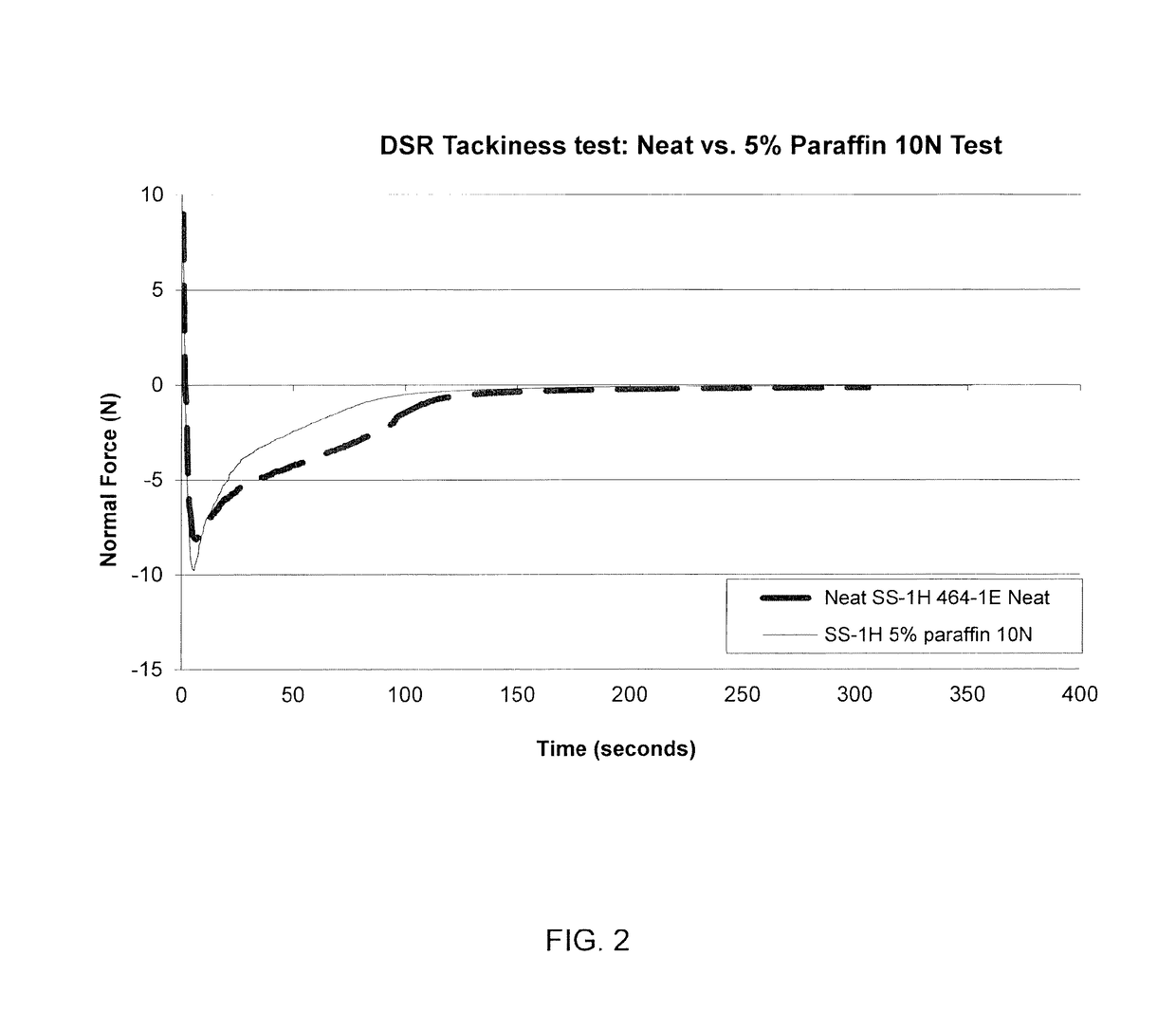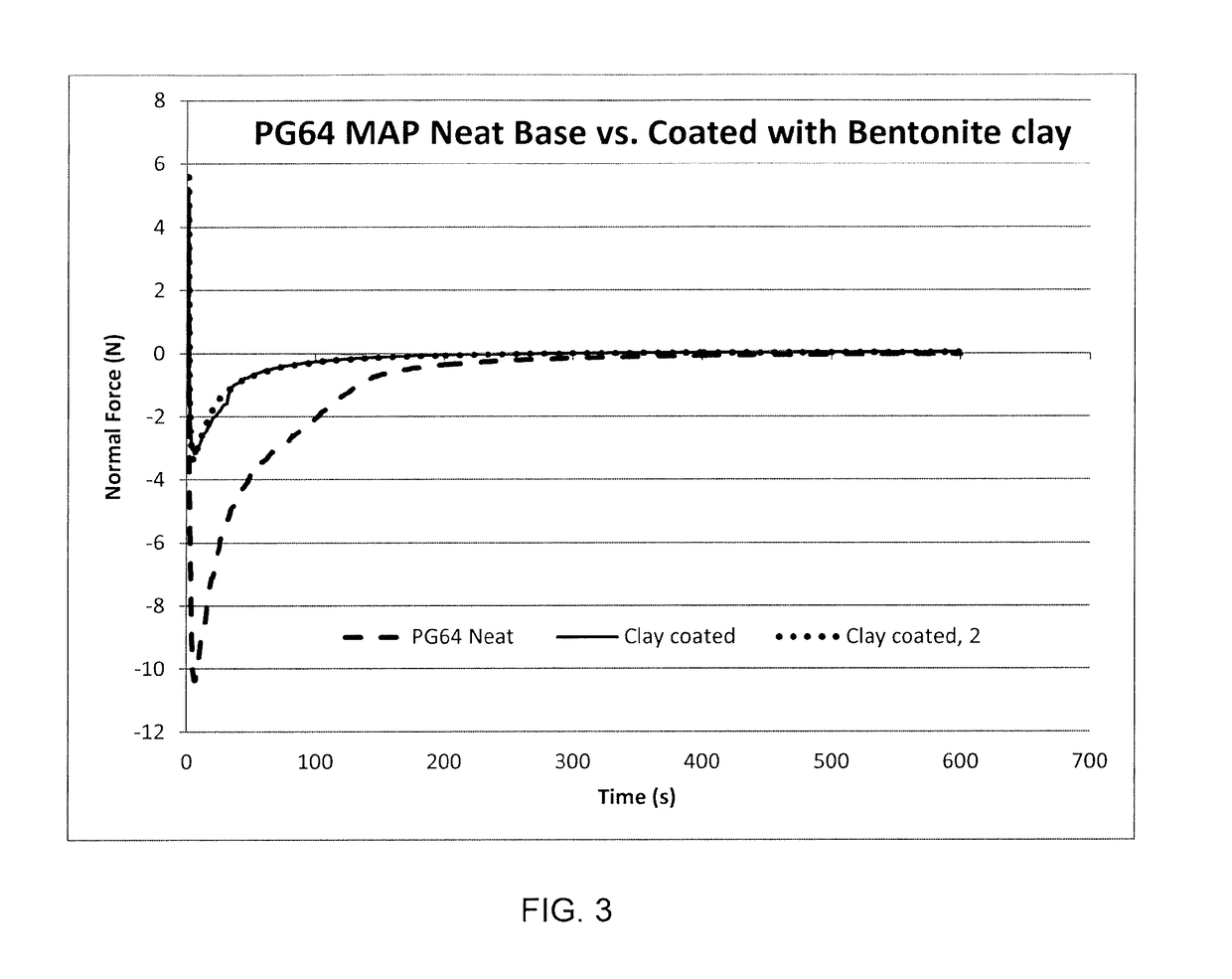Method for Producing Bituminous Coatings With Reduced Tackiness
a bituminous coating and reducing technology, applied in the field of bitumen coatings, can solve the problems of reducing the bond between the layers, affecting the quality of the coating, and affecting the appearance of the coating,
- Summary
- Abstract
- Description
- Claims
- Application Information
AI Technical Summary
Benefits of technology
Problems solved by technology
Method used
Image
Examples
example 1
[0045]An SS-1 H asphalt emulsion was measured for tackiness using a TA Instruments AR2000ex DSR. The SS-1H asphalt emulsion was prepared from a PG 64-22 asphalt binder through a colloid mill using Redicote E-7000 as the emulsifier, the PG 64-22 binder has a 51.6 PEN, and softening point of 123° F / 51° C. The SS-1H asphalt emulsion has a residue of about 62%.
[0046]Films were prepared from emulsion residue specimens, which were obtained by a low temperature recovery method based on ASTM D7497. The emulsion residues were prepared in silicone DSR molds; these molds are designed for asphalt binder specimen preparation for performance grading. Samples of the SS-1H asphalt emulsion are loaded by weight into the mold, and after curing, film discs of the cured asphalt emulsion residue with diameters of 19 mm are left in the mold. Then, a paraffin wax emulsion, Paramelt Syncera P1387, ˜45% solids, was painted onto the cured asphalt specimens in the molds with a small brush, and allowed to cure...
example 2
[0052]Surface tackiness of the same PG 64-22 asphalt binder used in example 1 and binders coated by wax emulsion, clay slurry and polymer latex were measured by TA Instruments AR2000ex DSR, using the tackiness test described above. The asphalt binder was melted and poured on a non-stick mat, the melted binder was then spread with a hot, clean spatula or rod to get relatively uniform thickness. The thickness of the asphalt layer was estimated using a calliper. Film discs of the cured asphalt with 8mm diameter were cut and loaded onto DSR plate for surface tack measurement, the film disc was trimmed using a razor blade before measurement. To apply a separate layer of wax emulsion, clay slurry or polymer latex, a portion of the asphalt layer was cut, placed on a small non-stick plate and weighed. Then, wax emulsion, clay slurry or polymer latex was painted onto the cured asphalt with a small brush, and allowed to cure to constant weight. The amount of wax emulsion, clay slurry or polym...
example 3
[0056]Surface tackiness of asphalt emulsion residue cured from the same SS-1 H asphalt emulsion as in example 1 and asphalt emulsion residue coated with wax emulsion were measured by TA Instruments AR2000ex DSR, using the tackiness test described above. The same wax emulsion as in example 2 was spray-applied onto an un-cured SS-1 H emulsion as follows: the SS-1 H asphalt emulsion was loaded into DSR sample molds. The wax emulsion was sprayed on top of the asphalt emulsion using a Paasche Talon TG1210 air brush. The wax emulsion was well atomized by the air brush for spraying at room temperature. The target spray coating was to apply 5% wax by weight of asphalt. The amount of wax emulsion applied was calculated by spraying the wax emulsion over a measured area for a given time, then weighing the material applied. The specimen molds containing the asphalt emulsion were covered with paper before spraying except for a hole cut out to expose the asphalt emulsion. This was done so that th...
PUM
| Property | Measurement | Unit |
|---|---|---|
| Temperature | aaaaa | aaaaa |
| Temperature | aaaaa | aaaaa |
| Length | aaaaa | aaaaa |
Abstract
Description
Claims
Application Information
 Login to View More
Login to View More - R&D
- Intellectual Property
- Life Sciences
- Materials
- Tech Scout
- Unparalleled Data Quality
- Higher Quality Content
- 60% Fewer Hallucinations
Browse by: Latest US Patents, China's latest patents, Technical Efficacy Thesaurus, Application Domain, Technology Topic, Popular Technical Reports.
© 2025 PatSnap. All rights reserved.Legal|Privacy policy|Modern Slavery Act Transparency Statement|Sitemap|About US| Contact US: help@patsnap.com



